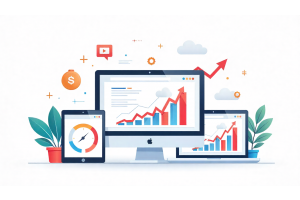E-commerce vs Dropshipping: Which Business Model Wins in 2025

E-commerce vs Dropshipping: Which Business Model Wins in 2025
E-commerce and dropshipping represent two distinct paths for online selling. Both let you sell products online, but they work differently. Understanding these differences helps you pick the right model for your goals and budget.
The global dropshipping market reached $366.76 billion in 2024 and is projected to hit $470.92 billion in 2025, while global e-commerce sales are expected to reach $9.3 trillion by 2027. Both models offer real opportunities, but they come with different challenges and rewards.
Table Of Content
Traditional E-commerce Explained
E-commerce means buying inventory upfront, storing it, and shipping products directly to customers when orders come in. You control the entire process from product selection to delivery.
How E-commerce Works
You purchase products in bulk from manufacturers or wholesalers. These products sit in your warehouse or storage facility. When a customer orders, you pack and ship the item yourself or use a third-party logistics provider (3PL). You manage inventory levels, restock products, and handle returns.
Core Features of E-commerce
Inventory ownership: You buy and store products before making sales. This requires significant upfront capital and storage space.
Complete control: You choose which products to sell, set your prices, and create your brand identity. You design the entire customer experience.
Direct fulfillment: You manage shipping times and package quality. This gives you control over delivery speed and unboxing experience.
Higher profit margins: Successful e-commerce businesses maintain gross profit margins between 50-70%, with net margins averaging 10% and top performers reaching 20%. You buy at wholesale prices and set retail prices that maximize profit.
Customer relationship management: You handle all customer inquiries, complaints, and returns. Building strong relationships drives repeat purchases.
Scalability: Growth requires expanding inventory, improving your website, and investing in marketing campaigns.
Tip
To enhance your eCommerce store’s performance with Magento, focus on optimizing site speed by utilizing Emmo themes and extensions. These tools are designed for efficiency, ensuring your website loads quickly and provides a smooth user experience. Start leveraging Emmo's powerful solutions today to boost customer satisfaction and drive sales!
Dropshipping Business Model
Dropshipping eliminates inventory management. You partner with suppliers who store products and ship orders directly to your customers. Your job focuses on marketing and customer service.
How Dropshipping Works
You list products on your website without buying them first. When a customer orders, you forward that order to your supplier. The supplier ships the product directly to your customer. You never touch the product.
Core Features of Dropshipping
Zero inventory: You don't buy products until customers order them. No warehouse needed.
Low startup costs: Initial dropshipping investment can stay under $100, making it accessible for new entrepreneurs with limited capital.
Supplier dependency: Your reputation depends on supplier reliability. Late shipments or poor quality hurt your business, but you don't control these factors.
Limited control: You can't control product availability, quality, or shipping speed. Suppliers make these decisions.
Lower profit margins: Typical dropshipping margins range between 15% to 30%. Competition is fierce and supplier pricing limits your markup.
Easy market entry: 84% of online sellers identify finding a reliable dropshipping supplier as their primary challenge, but the low barrier to entry attracts many entrepreneurs.
Key Differences Breakdown
| Factor | Traditional E-commerce | Dropshipping |
|---|---|---|
| Initial Investment | High (inventory + storage) | Low (under $1,000) |
| Inventory Management | Required | None |
| Profit Margins | 10–20% net margin | 15–30% typical |
| Control | Full control | Limited control |
| Fulfillment | In-house or 3PL | Supplier handles |
| Scalability | Requires capital | Rapid scaling possible |
| Risk Level | Higher financial risk | Lower financial risk |
| Time to Start | Weeks to months | Days to weeks |
Investment Requirements
E-commerce demands substantial upfront capital for inventory, warehouse space, and website development. You might need $10,000–$50,000 to start properly.
Dropshipping requires minimal capital. You pay for a domain, hosting, and basic marketing. Most entrepreneurs start with less than $500.
Control and Branding
E-commerce gives you complete control. You select products, create packaging, control quality, and build a unique brand identity. You can customize everything.
Dropshipping limits your control. Suppliers determine product quality and shipping speed. You rely on their performance for your reputation.
Order Fulfillment
E-commerce businesses handle fulfillment in-house or through 3PLs. You control shipping times and can include branded packaging. This creates a consistent customer experience.
Dropshipping outsources fulfillment to suppliers. You depend on their efficiency and accuracy. Shipping times vary and you can’t customize packaging.
Profit Margins Comparison
E-commerce delivers higher margins per sale. Direct-to-consumer brands typically maintain 30–50% gross margins. You buy wholesale and set retail prices with significant markup.
Dropshipping results in lower margins due to competitive pricing and supplier costs. However, high-ticket dropshipping products can deliver profit margins over 50% with advanced marketing strategies.
Customer Service
E-commerce retailers manage all customer interactions directly. You control the entire experience from inquiry to return. Building relationships drives loyalty.
Dropshippers handle customer service but must coordinate with suppliers for product issues. This adds complexity and response time.
Business Scalability
E-commerce scaling requires inventory investment and warehouse expansion. Growth is constrained by capital and storage capacity.
Dropshipping scales rapidly without inventory constraints. Over 27% of online retailers now use dropshipping as their main order fulfillment method. You can add unlimited products without physical limitations.
Market Trends and Statistics
The fashion segment held the largest dropshipping market share in 2024, with over 34%. Fashion products are highly customizable, allowing dropshippers to create unique offerings with decent profit margins.
The number of online shoppers is expected to grow to 288.45 million in 2025, adding nearly 15 million new digital consumers. This growth creates opportunities for both business models.Only 10% of dropshippers achieve success in their first year, highlighting the competitive nature of the model. Success requires strong marketing and supplier relationships.
Select e-commerce if you:
- Have $10,000+ in startup capital
- Want complete control over product quality and branding
- Can handle inventory management and fulfillment
- Aim for higher profit margins per sale
- Plan to build a premium brand
Choose dropshipping if you:
- Have limited startup capital (under $1,000)
- Want to test products without inventory risk
- Prefer minimal hands-on management
- Accept lower profit margins for reduced risk
- Want to scale quickly without inventory constraints
Hybrid Approach
Many successful entrepreneurs combine both models. You might maintain inventory of best-selling products while dropshipping accessories or new items. This hybrid approach reduces risk while maximizing control over popular products.
Start with dropshipping to test market demand. Once you identify winning products, consider purchasing inventory for direct fulfillment. This improves profit margins and customer experience.
Success Factors for Both Models
E-commerce Success
Focus on product differentiation. Ecommerce businesses should aim for a gross profit margin between 40% to 80%. Optimize your supply chain to reduce costs and improve margins.
Invest in customer experience. Fast shipping, quality packaging, and responsive service build loyalty and drive repeat purchases.
Dropshipping Success
Find reliable suppliers. 84% of sellers cite supplier reliability as their primary challenge. Test multiple suppliers before committing.
Focus on niche markets where you can differentiate through marketing and customer service. The beauty, health, personal, and household care niches are the most common sectors where dropshipping is used.
Build your brand despite limited product control. Create compelling content, provide excellent customer service, and develop a unique value proposition.
Conclusion
E-commerce offers higher profit margins and complete control but requires significant capital and inventory management. Dropshipping provides low-risk entry and rapid scaling but delivers lower margins and limited control.Yes, eCommerce remains highly profitable in 2025, with global online sales projected to surpass $7 trillion. Both models work when executed properly. Your choice depends on available capital, desired control level, and business goals. Consider starting with dropshipping to validate demand, then transition to traditional e-commerce as you grow. This strategy minimizes risk while building toward higher profitability.
FAQs
What is the main difference between E-commerce and Dropshipping?
The main difference lies in inventory management and fulfillment. Traditional E-commerce requires you to purchase, store, and ship products yourself, while Dropshipping lets suppliers handle storage and fulfillment — you only manage marketing and sales.
Which model requires more initial investment in 2025?
Traditional E-commerce demands a higher upfront investment for inventory, warehousing, and logistics. Dropshipping, however, can start with under $1,000 since you don’t need to buy products in advance.
Which business model is more profitable?
Dropshipping generally offers 15–30% profit margins, while Traditional E-commerce averages around 10–20%. However, E-commerce allows for higher long-term profitability through brand control and bulk purchasing.
Who controls product quality and branding?
In Traditional E-commerce, you have full control over product quality, packaging, and brand presentation. Dropshipping gives limited control since products come directly from suppliers, which can affect consistency and quality assurance.
Which model scales faster in 2025?
Dropshipping scales faster because you don’t need to manage inventory or logistics — you can test new products quickly. Traditional E-commerce requires more capital and operational setup to scale.
What are the risks of each model?
Traditional E-commerce carries higher financial risk due to upfront inventory investment. Dropshipping has lower financial risk but higher operational risk — supplier delays or quality issues can harm your brand.
Which is better for beginners in 2025?
Dropshipping is generally better for beginners because it’s low-cost and easy to start. You can test markets without major investment. Traditional E-commerce suits experienced entrepreneurs aiming for long-term brand ownership.
How long does it take to launch each business?
A Dropshipping store can launch within days or weeks, while a Traditional E-commerce business may take weeks to months due to product sourcing, inventory setup, and logistics planning.
Can I combine both E-commerce and Dropshipping?
Yes. Many hybrid businesses use Dropshipping to test products before investing in bulk inventory. Once a product proves successful, they shift to Traditional E-commerce to improve profit margins and control.
Which model is expected to perform better in 2025?
In 2025, Dropshipping remains attractive for its low entry barrier and flexibility, while Traditional E-commerce continues to dominate for brand-building and higher long-term stability. The best choice depends on your goals, capital, and growth strategy.




